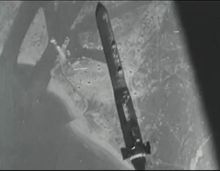Disney bomb
| Disney bomb | |
|---|---|

A Disney bomb just after release
|
|
| Type | Bunker buster bomb |
| Place of origin | United Kingdom |
| Service history | |
| In service | 1945–46 |
| Used by | United States Army Air Forces |
| Wars | World War II |
| Production history | |
| Designer | Edward Terrell |
| Designed | 1943 |
| Manufacturer | Vickers Armstrong |
| Specifications | |
| Weight | 4,500 lb (2,000 kg) |
| Length | 16 ft 6 in (5.03 m) |
| Diameter | Body: 15 in (380 mm) Tail 17 in (430 mm) |
| Warhead | Shellite |
| Warhead weight | 500 lb (230 kg) |
|
Detonation
mechanism |
Base fuze |
|
|
|
| Propellant | Cordite |
|
Launch
platform |
Aircraft |
| Transport | Boeing B-17 Flying Fortress, Boeing B-29 Superfortress |
The Disney bomb, also known as the Disney Swish, officially the 4500 lb Concrete Piercing/Rocket Assisted bomb was a rocket-assisted bunker buster bomb developed during the Second World War by the British Royal Navy to penetrate hardened concrete targets, such as submarine pens, that could resist conventional free-fall bombs. Devised by Royal Navy Captain Edward Terrell, the bomb was fitted with solid-fuel rockets to accelerate its descent, giving it an impact speed of 990 miles per hour (1,590 km/h) — substantially beyond the 750 miles per hour (1,210 km/h) gravity-propulsion impact velocity of the 5 tonne Tallboy munition for comparable purposes — and hence the ability to penetrate 16 ft (4.9 m) of solid concrete before detonating. The name is attributed to a propaganda film produced by the Walt Disney Studios, that provided the inspiration for the design.
The Disney bomb saw limited use by the United States Army Air Forces in Europe from February to April 1945. Although technically successful, it initially lacked the pinpoint accuracy required for bunker targets. It was deployed late in the war and had little effect on the Allied bombing campaign against Germany.
During the Second World War, Barnes Wallis developed two large "earthquake" bombs for the Royal Air Force: the five-tonne Tallboy and the ten-tonne Grand Slam, for use against targets too heavily protected to be affected by conventional high explosive bombs. These enormous weapons were designed to strike close by their target, to penetrate deeply into the earth, and to cause major structural damages by the shock waves transmitted through the ground. In practice, they proved capable of penetrating a significant thickness of concrete if they scored a direct hit despite not being designed for that purpose by Wallis, who had to work within the accuracy limitations of current bombsights and the resulting low accuracy of the bombings.
...
Wikipedia
